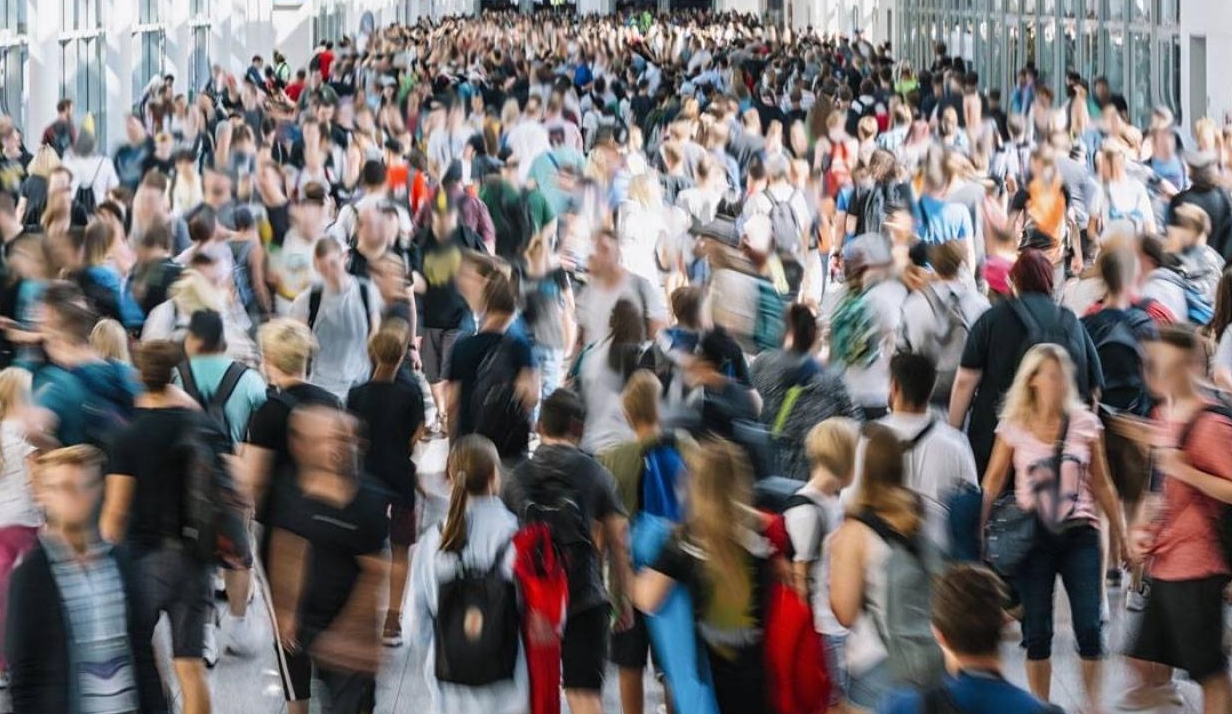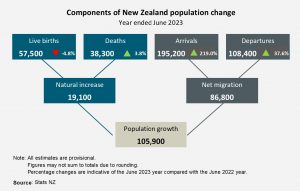
New Zealand Records a Total Population of 5.22 Million (June 2023 Census)
As of this June, New Zealand’s total population has been documented at 5.22 million individuals. According to the latest data from the statistics bureau, the total population until this June has witnessed an increase of 109,900 compared to the previous year, yielding an annual growth rate of 2.1%. This population surge is predominantly attributed to the rise in immigrant arrivals, exerting a more substantial impact than natural growth.
Until June of 2022, the annual net immigration rate registered a decrease of 17,600 individuals due to the prevalence of a pandemic outbreak. Consequently, up to June 2021, growth rates remained low at 0.4%, and even until June 2022, the increase rate stood at a modest 0.1%.
New Zealand’s overall population comprises a combination of natural growth – reflecting births and deaths – and the net immigration figure. For the period up to June this year, annual natural growth has been hampered by a decrease in newborns and an increase in deaths, resulting in a net gain of 19,100 individuals. The number of registered newborns stands at 57,500, indicating a 4.8% decline compared to the previous year, while deaths have risen to 38,300, representing a 3.8% increase.
The natural population increase for the year 2023 has reached its lowest point since 1943. This decline is attributed to the intensifying phenomenon of population aging, compounded by the increased number of deaths due to the impact of the COVID-19 pandemic.
Meanwhile, the notable growth occurred within the population segment of 15 to 39-year-olds, showcasing an annual increase of 3.3%. This demographic exhibited the highest growth rate among age groups. Notably, this surge can be attributed to a rise of 56,200 individuals within the working-age population, equating to a daily increase of 154 persons, signifying that two-thirds of net immigrants fall within this age bracket. In contrast, the 0 to 14-year-old age group experienced an increase of merely 4,600 individuals annually, resulting in a growth rate of 0.5%, marking the lowest rate since 2005.
Additionally, the influx of individuals born in the 1950s into the 65 and over age group has led to an annual increase of 23,900, averaging around 65 individuals daily. This age group has consequently recorded an annual growth rate of 2.8%, surpassing the number of deaths and thus accelerating the aging of the population.

뉴질랜드 총 인구 522만명으로 기록(2023년 6월 집계)
올해 6월 현재, 뉴질랜드의 총 인구는 522만 명으로 기록되었다. 최신 통계국 자료에 따르면, 올해 6월까지의 총 인구는 전년 대비 10만 5900명 증가하여 연간 증가율 2.1%를 기록했다. 이 인구 증가는 주로 이민자의 입국 증가에 기인하며, 자연증가보다 더 큰 영향을 미쳤다.
2022년 6월까지는 전염병 대유행으로 인해 연간 순이민자가 마이너스 1만 7600명을 기록한 바 있다. 이로 인해 2021년 6월까지는 0.4%의 증가율, 2022년 6월까지도 0.1%의 증가율로 낮은 수치를 기록했다.
뉴질랜드의 총인구는 신생아 출생과 사망자 수를 반영한 자연증가와 이민자의 순이민자 수를 합한 조합으로 이루어진다. 올해 6월까지의 연간 자연증가는 신생아 출생 감소와 사망자 증가로 인해 1만 9100명으로 나타났다. 신생아 등록 수는 5만 7500명으로 작년 대비 4.8% 감소하였고, 사망자는 3만 8300명으로 3.8% 증가하였다.
2023년의 자연증가 인구는 1943년 이후 최저치로 나타났다. 이는 인구 고령화와 코비드-19로 인한 사망자 증가로 인해 자연증가율이 감소한 결과이다.
한편 인구 증가분 준 15~39세 그룹이 연간 3.3% 늘어나면서 연령대 중 증가율이 가장 높았다. 이는 근로 가능대인 이 그룹의 인구가 연간 5만 6200명, 하루 기준으로는 154명씩이나 늘어난 셈으로 실제로 순이민자의 2/3가 이 연령대에 속했다.
반면 0~14세 그룹은 하루 13명 이하인 연간 4600명이 증가하면서 증가율이 0.5%에 불과해 연령대 중 가장 증가율이 낮았으며 2005년 이후 최저 수치이다.
또한, 1950년대에 태어난 세대가 65세 이상 그룹으로 진입하면서 연간 2만 3900명, 하루 평균 65명이 증가하였다. 이러한 추세로 인해 65세 이상 인구는 연간 2.8%의 증가율을 기록하며, 노령화 현상이 가속화되고 있다.

